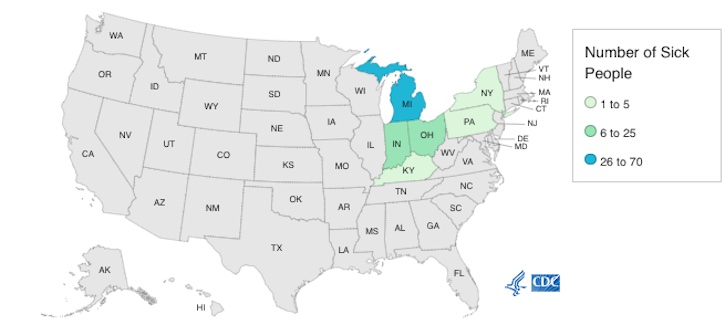Updated October 5, 2022: With final information after CDC declared an end to the outbreak.
An E. coli outbreak linked to Wendy’s burgers and sandwiches with romaine lettuce has ended with 109 illnesses, according to the Centers for Disease Control and Prevention (CDC). The six-state outbreak included 52 hospitalizations, 13 of them for hemolytic uremic syndrome (HUS), a form of kidney failure that affects some E. coli patients, most often small children.
Health officials received detailed food histories from 82 of the patients, 68 of them, or 83 percent reported eating at Wendy’s in the week before they became ill. Of the 68 people who recalledd eating at at Wendy’s, 46 said they ate sandwiches or burgers topped with romaine lettuce. The Wendy’s restaurants where these patients ate were located in Indiana, Kentucky, Michigan, New Jersey, Ohio, and Pennsylvania.
When the problem was initially discovereed in mid-August, Wendy’s said it had removed the romaine it uses for its sandwiches from the affected region. The company uses a different romaine for its salads.
The outbreak includes illnesses in six states: Indiana (11), Kentucky (2), Michigan (67), New York (1), Ohio (24), and Pennsylvania (4 ). Some people included in this outbreak have reported having eaten at Wendy’s locations in Pennsylvania, Michigan, and Ohio.

Were you sickened with E. coli?
State health departments conducted genetic tests on the E. coli O157:H7 samples cultured from patients. This type of testing can identify the genetic “fingerprint” of the E. coli strain, enabling them to find linkages. Tests completed showed that cases from six states are linked. This means that the patients were exposed to the same contaminated food source. Romaine lettuce was the suspected source, but FDA investigators could not confirm the link.
E. coli Outbreak Cases in Ohio and Michigan
The initial outbreak investigation began after a surge in E. coli cases were reported in Ohio and Michigan. In the first three weeks of August, a total of 98 E. coli infections in Kent, Ottawa, and Oakland counties in Michigan and 18 E. coli infections in Wood County, Ohio were reported. Both of those totals far exceed the number of cases reported in a typical month.
On August 19th the Michigan Department of Health (MDH) reported outbreak cases in 17 counties: Allegan, Branch, Clinton, Genesee, Gratiot, Jackson, Kent, Macomb, Midland, Monroe, Muskegon, Oakland, Ogemaw, Ottawa, Saginaw, Washtenaw, and Wayne; as well as the City of Detroit. Fifty-six percent of cases in Michigan have led to hospitalizations, almost twice the average hospitalization rate. Four of the patients in Michigan have developed HUS.
On August 22, the Ohio Department of Health (ODH) reported 19 known cases associated with the outbreak. The illnesses were reported from the following counties: Wood (7), Lorain (3), Cuyahoga (2), Lucas (2), Mahoning (2), Clermont (1), Franklin (1), and Summit (1).
E. coli Outbreak Cases in Pennsylvania, Indiana, New York, and Kentucky
Within weeks of the initially reported cases in Michigan and Ohio, cases were also reported in Indiana, Kentucky, New York and Pennyslvania. Those cases were also genetically linked to the existing outbreak.
E. coli O157:H7 and HUS Symptoms
E. coli O157:H7 is one of a handful of Shiga-toxin-producing E. coli (STEC). Shiga toxins are poisonous to humans and cause severe illness. The CDC had hospitalization information for 97 of the patients. Of those, 52 were hospitalized. That’s a 54 percent hospitalization rate, much higher than the 30 percent average for E. coli outbreaks.
Symptoms of an E. coli infection, which include fever, abdominal cramps, and diarrhea that is sometimes bloody, usually develop within one to three days of exposure. The people sickened in this outbreak, who range in age from 1 to 94 years old, said they first became ill on dates ranging from July 26, 2022, to August 17, 2022. Over-the-counter anti-diarrheal medications and antibiotics should not be given to patients with E. coli infections as they can increase the chance of developing HUS.
Symptoms of HUS usually develop a week after initial E. coli symptoms. Anyone with HUS symptoms should seek immediate emergency care. HUS symptoms include:
- Pale skin
- Unexplained bruising
- Extreme fatigue
- Decreased urination
- Bloody diarrhea
- Shortness of breath
- Swelling in legs, feet, or ankles
E. coli Outbreak Investigation
When the CDC announced the outbreak on August 17, it said that both the USDA and the FDA were collecting evidence to determine the source of the outbreak. But only one of the agencies has an active E. coli investigation posted on its website.
The U.S. Department of Agriculture’s Food Safety and Inspection Service (USDA FSIS) regulates meat and poultry. The “Outbreak Response” page on its website was updated on August 17, the same day the CDC announced the outbreak, and it shows no active investigations. But that day, the U.S. Food and Drug Administration (FDA), which regulates all other foods, posted a new E. coli O157:H7 investigation on its website along with a notification that a “traceback” investigation is underway.
This means that when outbreak patients were interviewed about the foods they ate in the days before they became ill, a significant number of them named the same food. And FDA investigators were tracing back that food item’s journey from the point of sale to the place it was grown. By August 31, the FDA had initiated an on-site inspection, and begun to collect and analyze samples.
Pacific International Marketing, “a key Wendy’s supplier,” according to a Bloomberg News story, has posted a statement on its website saying it is aware of the outbreak and will continue to monitor the situation. Coastline Family Farms was also identified in the Bloomberg story as a big romaine supplier to Wendy’s.

Before the CDC confirmed that Wendy’s was the source of the outbreak, people on Facebook were talking about the likely connection. On August 12, five days before the CDC announcement, one person posted about a potential E. coli outbreak at Wendy’s in Oakland County, MI. Days before that, a woman receiving treatment for her illness posted about Wendy’s being the suspected cause of her probable E. coli infection. And on August 17, a Michigan man posted that a friend’s 11-year-old daughter got “Shiga toxin E. coli from a burger at Wendy’s” and developed HUS.
Wendy’s hamburgers are served with tomato, onion, pickles, and romaine lettuce, which caused more than half of the 40 STEC outbreaks linked to leafy greens between 2009 and 2018. Leafy greens are the source of more E. coli outbreaks than any other food except ground beef, according to the CDC.
Experienced E. coli Lawyers
If you developed an E. coli infection from contaminated food and would like a free consultation with an experienced E. coli lawyer, please contact our E. coli Legal Team. We have represented clients in every major E. coli outbreak in the U.S. including this one. You can reach us by calling 1-888-377-8900, sending a text to 612-261-0856, or by completing the form below. The consultation is free and there is no obligation.